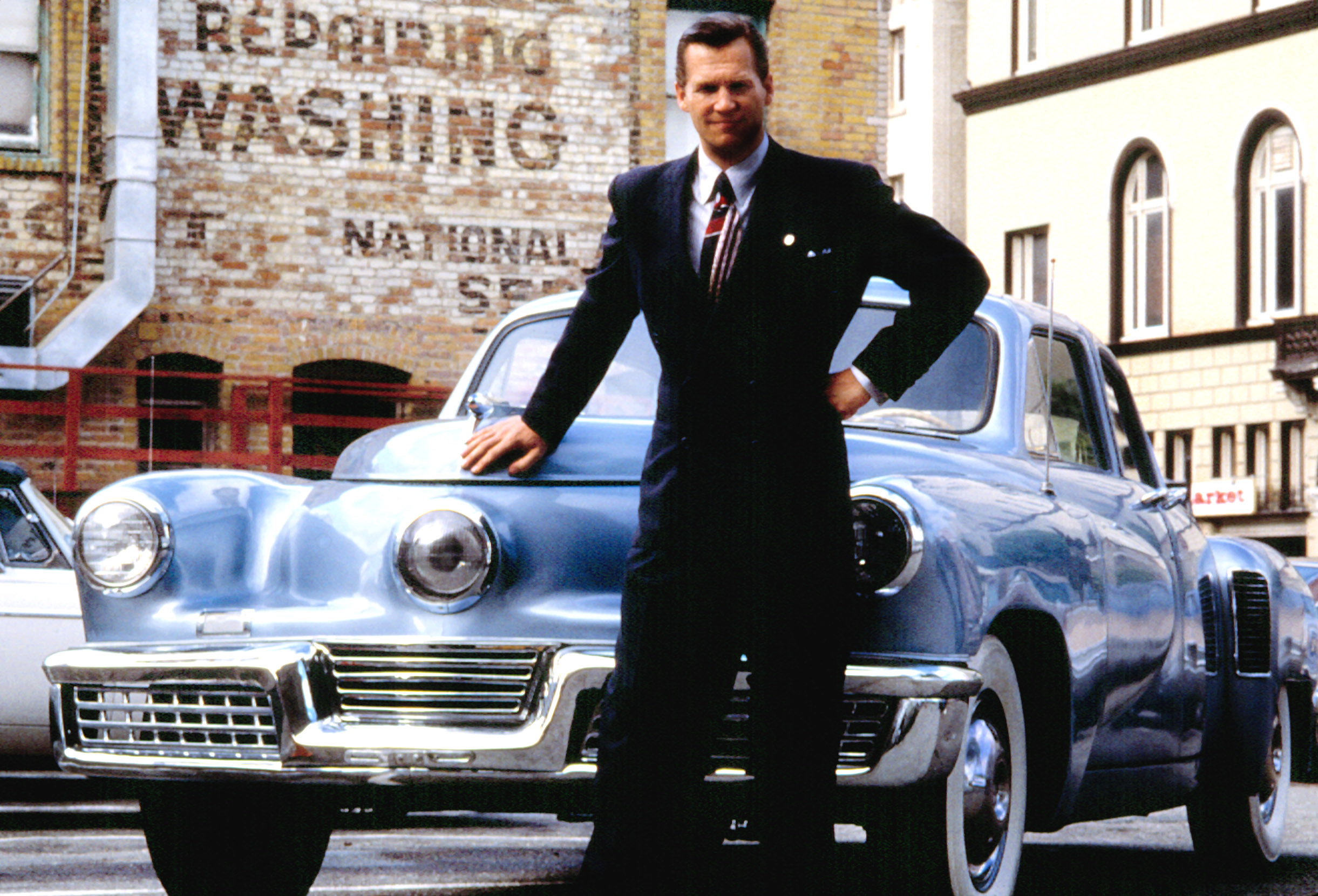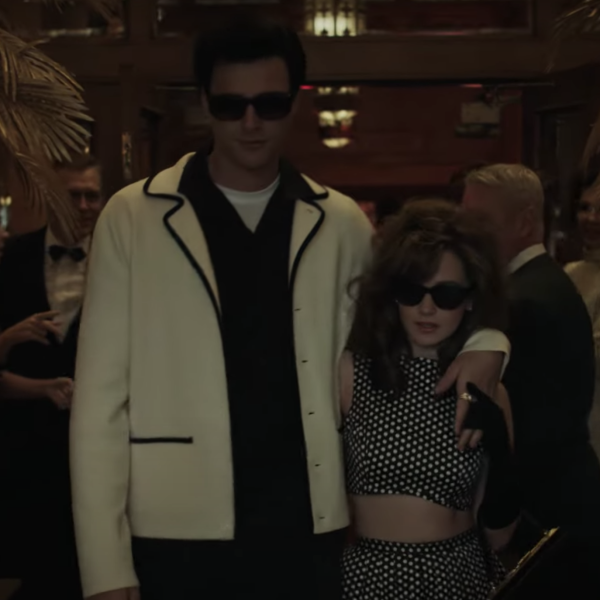“Chances are you’ve never heard of Preston Thomas Tucker; dreamer, inventor, visionary — a man ahead of his time.”
Chances are you’ve never heard of the movie made about him either. Like the car he had created in his name, it came and went in nearly the same breath. And yet, also like the car, the film’s legacy and staying power lies in the strength of its parts, as well as the personal passion put into it by its maker, Francis Ford Coppola. In fact, it’s hard not to watch his 1988 film “Tucker: The Man and His Dream” and discern a link between Coppola and the film’s eponymous character. Played by a still boyish Jeff Bridges with a glint in his eye and a manic energy that veers between zealous enthusiasm and fevered paranoia, Tucker is a man entwined with his dreams. Much like Coppola, he is driven by family, innovation, and an uncompromising sense of purpose. Also like Coppola, Tucker’s can-do attitude eventually bumps up against the powers-that-be, stifling his pursuit of progress in favor of the status quo. As Coppola continues to seek U.S. distribution for his current film, the sci-fi statement piece “Megalopolis,” looking back on “Tucker” may provide fans and naysayers alike a perspective on how the filmmaker searches for hope with his work in spite of all of the forces against him.
Coppola’s desire to bring wider awareness to Preston Tucker’s story began during his post-“Godfather” success, at different points courting Marlon Brando, Jack Nicholson, and Burt Reynolds to take on the lead role, but the seeds of this dream were first sown during his childhood. He was born in 1939 — a standout for one of the best year’s in cinema history — in Detroit, Michigan, where his father worked for “The Ford Sunday Evening Hour,” a radio series featuring concert music produced by Ford Motor Company. Despite being employed by one of The Big Three automakers of the time (Ford, General Motors, and Chrysler), Coppola’s father was also an investor in Tucker stock and bought one of the 50 Tucker cars produced off the production line. Seeing this symbol of creative ingenuity growing up proved an incredible influence on Francis and by the time he attended UCLA School of Theater, Film, and TV in the ‘60s, he had already started thinking of how he could present Tucker’s life on the big screen.
In true Coppola fashion, his initial conceptions for the picture were experimental in nature, incorporating a musical element, as well as storylines featuring figures who were only cosmically a part of Tucker’s life like Thomas Edison, Henry Ford, and Andrew Carnegie. Coppola also spent time working with “Singin’ in the Rain” screenwriting duo Betty Comden and Adolph Greene, as well as composer Leonard Bernstein, but when his ill-fated Vegas-set, studio-shot musical “One from the Heart” sank Zoetrope Studios, sending him into millions of dollars of debt, “Tucker” was put on the back burner. For the next six years, Coppola would pay penance by working on other people’s projects for a rate of $2.5 million plus 10% of the profits. Unfortunately, only two of the five movies he made during this period — “The Outsiders” and “Peggy Sue Got Married” — earned any significant box office.
Plans to produce “Tucker” were finally revived in 1986 by Coppola’s friend and colleague, George Lucas, who he’d helped fund “American Graffiti” during their rise in the ‘70s. Now, nearly fifteen years later, Lucas decided to return the favor, albeit in a much grander, more generous way befitting the vast monetary success he’d accumulated in the time in between. Putting up a budget of $24 million, as well as offering a tonal reshift of the material, Lucas gave Coppola a chance at crafting something he’d been wanting to make for years, while at the same time, helping him find a way to do so in a marketable way for audiences. It wouldn’t be exactly Coppola’s vision, but enough to make having any vision worthwhile again. There were personal reasons behind Lucas’ generosity as well. In 1987, while Francis was filming “Gardens of Stone,” his eldest son, Gian-Carlo, died in a boating accident at only 22.
The loss was obviously devastating for Coppola and his family, which is why even though he honored his commitment to “Tucker,” he did so while shooting most of the Midwest-set story in Northern California where he could be with his wife and two remaining children. In addition to Lucas, Coppola also reteamed with “Apocalypse Now” and “One from the Heart” cinematographer Vittorio Storaro, whose golden hues provide “Tucker” with a sheen of sincerity that initially matches the American exceptionalism on display, then eventually comes to mock it, only to bring viewers back around in the end. The whole film, in fact, pays great homage to the jaunty, upbeat consumerism of post-WWII America, as well as the work of Frank Capra. Like “Mr. Smith Goes to Washington” — ones of those standouts from 1939 — or “It’s A Wonderful Life” — which would’ve been released around the same time Tucker went through his own conflict with the American Dream — “Tucker” aims to balance the promises of an America founded on freedom and possibility with the reality of a country beholden to those in seats of power.
In a New York Times Magazine profile written around the time of the film’s release, Coppola said of the final product, “I think it’s a good movie — it’s eccentric, a little wacky, like the Tucker car — but it’s not the movie I would have made at the height of my power.”
There’s many reasons Coppola may not consider “Tucker” his favorite film he’s worked on, but the one that stands out the most is the idea of how much he saw himself in this failed inventor whose gifts to the world were fleeting. While the quality of the film does not reflect Coppola’s judgment of it, its narrative does speak to the madness sparked by the withholding of vision, both internally and with the public at large. In one of film’s quieter, more touching moments, Tucker’s business partner, Abe Karatz, played by Martin Landau in an Academy-Award nominated performance, has to tell his beloved comrade that the government is coming after them and that he’s made them vulnerable by being a convicted felon. He knew he was putting the whole company at risk from the beginning, but like Tucker, he was wrapped up in the magic of the mission. Through tears, Landau’s character tells Bridges’, “How was I to know that if I’d get too close I’d catch your dreams?”
The great irony in this is that while this moment is played for melodrama, the truth is, all Tucker wants is for people to be able to catch his dreams. And Coppola does too. But like The Big Three auto manufacturers, Coppola’s art form — his method of distributing dreams if you will — was and is largely beholden to a studio system that prioritizes what is known above what is unknown. This is to say, if a studio knows a comic book character or a novel or any kind of IP have a built-in fan base, the likelihood of it profiting off an adaptation of that material rises exponentially. Or if somehow an original movie does get made and succeeds financially, the likelihood of sequels to that film also succeeding is all but guaranteed. It’s why Paramount was clammoring for “The Godfather Part III” shortly after the release of “Part II” and also why Coppola resisted making it. He didn’t want to feed into a culture that commodifies everything and forces art to be entertainment. The fact that he had most of the control while making “Tucker” and still had to compromise his own vision for the sake of palatability was most likely a crushing blow and one that echoes throughout the narrative.
Towards the end of the film, during Tucker’s big courtroom plea, Bridges delivers a few lines that encompass everything Coppola is trying to tell audiences about appreciating creativity despite living in an environment that abhors it. In speaking of himself and others, Tucker says, “The loner, the dreamer, the crackpot who comes up with some crazy idea that everybody laughs at that later turns out to revolutionize the world — he’s squashed from above before he even gets his head out of the water. Because the bureaucrats, they’d rather kill a new idea than let it rock the boat.”
If ever there was a cinematic boat-rocker, it would be Francis Ford Coppola, and if ever there was a film that honored that creed, while at the same time retaining a classic, Old Hollywood traditionalism, it would be “Tucker: The Man and His Dream.” Unfortunately, perhaps due to that old-timiness or Coppola’s own slight shunning of the movie, and despite garnering his strongest critical praise in years, the film did not succeed at the box office. Coppola — at that point relieved he could still get anything made — later agreed to write and direct “The Godfather Part III” for Paramount — who picked up production costs on “Tucker” and agreed to distribute most likely to earn Coppola’s favor — and would spend the rest of the ‘90s remaining a director-for-hire instead of producing his own work. He eventually took a break between 1997 and 2007, investing more time into teaching and his other business ventures before returning to film on a much smaller scale, where he could pay for everything and achieve his cinematic visions without studio interference.
”I’m almost 50 years old,” Coppola said almost 35 years ago in his New York Time Magazine profile. “I have to focus more on what I want to say.”
At the time, he even specifically referenced the work he started on “Megalopolis,” calling it “a story set in contemporary New York that draws parallels with the decadence and decline of ancient Rome,” and describing the process he wished to undertake with it as “a whole other way we can do cinema.”
For decades, Coppola has been trying to warn us of the corruptive influence moneyed power has over our society and our ability to grow in positive ways, but our ability to listen has often been stifled by those very same powers. With “Tucker,” he rails against this injustice while at the same time taking joy in what he can, like family and the friends who stand by him. The darkness and tragedy of Tucker’s failure is in there, just underneath a lot of hope and positivity. With Coppola’s current film, “Megalopolis,” that darkness rises to the top, as he’d prefer, while his sense of hope becomes the subtext. If he learned anything from “Tucker,” it was to keep his family close, an act he continues to this day, even bringing most of them out to Cannes. Whether the film finds the kind of distribution it seeks in America also seems irrelevant to Coppola now, as he at least got to make it the way he wanted to. Even Tucker made 51 cars, many of which still work to this day. Even if you don’t know his name or his movie, his accomplishments still exist and Coppola’s do too.






